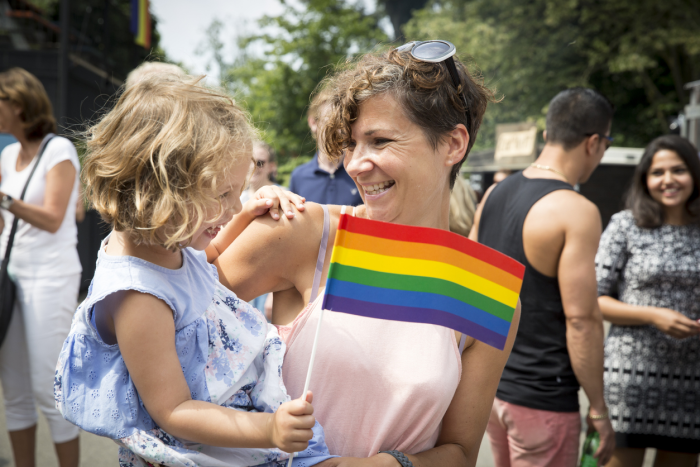June is pride month and it’s very important for people members of the LGBTQ+ community. It’s empowering for them to celebrate who they are. If your child is interested in learning more about pride month, we have a responsibility to teach them about inclusivity. There are so many family-friendly ways to show support. All people deserve equal rights regardless of their gender identity and sexual orientation. Below are some ways that your kids can get involved and celebrate pride month.
The History of Pride Month
The Stonewall Riots in New York City were a huge point in history for the gay rights movement. The police raided a gay bar at Stonewall Inn on June 28, 1969. This led to the violent protests that occurred for 6 days right outside that bar. Of course, this wasn’t the first or last raid as it was illegal in New York City to solicit sexual relations between anyone of the same sex.
The Stonewall Inn became a refuge for LGBT people in the 1960s because they were welcomed without judgment. It was seen as an escape for them. A safe space where they could freely express themselves. Even drag queens were allowed as they were frowned upon in other establishments.
The Pride rainbow flag for was designed by a man named Gilbert Baker in 1978. It started with 8 colors and each was a symbol. They were pink for sexuality, red for life, orange for healing, yellow for the sun, green for nature, turquoise for art, indigo for harmony, and violet for the soul. Several other colors have been added since then. They are pink and blue for transgender and black and brown for black and Latinx people.
What Does LGBTQ Stand For?
LGBTQ is an acronym and you will sometimes see LGBTQIA or LGBTQ+ as well. Here is what they stand for. Taking the time to learn this terminology is another easy way to show support. The same goes for using someone’s proper pronouns. If you’re ever unsure, just ask! It shows respect, too.
L - Lesbian
17 Easy Ways for Teens To Make Money Online Fast
Long gone are the days when fast food fryers and movie theater ticket taker positions ala “Fast Times At Ridgemont High” ruled the teen job market. Today’s high schoolers have more options than minimum-wage mall-bound gigs. Read More
G - Gay
B - Bisexual
T - Transgender
Q - Queer
I - Intersex
A - Asexual
+ - This symbol is for anyone who is part of the community but does not put a label on their gender identity.
1. Attend a Local Event

There are a lot of possibilities when it comes to local events. You can look online to see where a Pride Parade or Pride March is taking place near you. It’s a great opportunity to get dressed up in rainbow and support the LGBTQIA community. There are even Drag Queen story hours that you can attend as well. They are fun, educational, and family-friendly.
2. Donate
You can choose to get involved and donate to well-known nonprofit organizations like:
- The Trevor Project is dedicated to supporting the mental health of LGBT people. They have crisis services available 24/7.
- The Human Rights Campaign Foundation is dedicated to the health, wellness, and inclusivity of LGBTQ+ people in the workplace and health care settings.
- The Family Equality Council provides advocacy for same-sex couples who want to start a family as well as providing important resources for them.
3. Purchase Books to Educate

If you are wanting to teach your child more about pride and what it means, there are several children’s books that can help. A couple of our favorites will be listed below if you are not sure where to start.
- Love Makes a Family by Sophie Beer
Families can look different. Some children have a mom and a dad, two moms, two dads, or are even being raised by grandparents. The important part is the love that you share because after all, love is love. - It Feels Good to Be Yourself: A Book About Gender Identity by Theresa Thorn
If you ever wondered what gender identity means, this book can help. It teaches that you can be a boy, a girl, or somewhere in between. It is a wonderful reminder that it is only one part that makes you who you are. - The Little Book of Pride: The History, the People, the Parades by Lewis Laney
This book is filled with so much information about pride. From the Stonewall Riots to inspirational quotes from famous queer people, it is both educational and motivational. It would make a great gift for an LGBTQ youth as well.
4. Share Stories of Queer Family Members
If you have family members that are a part of the LGBTQ community, you can reach out to them and see if they are willing to talk to your little about their gender identity or even their coming out story. Hearing personally from a queer person is a great way to learn more about pride and why it’s so important. Of course, this also includes you as well. As a parent, you can still identify as transgender, bisexual, etc. Learning more about you and who you are will also deepen the connection you have with your child or children.
5. Support Local Queer Owned Businesses
Giving back to locals in your community is a wonderful way to celebrate pride month. If you don’t know of any local queer-owned businesses near you, a quick social media or internet search should be helpful. If not, take a look at websites such as Etsy and buy some homemade pride wear. This is a great way to show support.
7. Throw a Pride Party

You can celebrate pride right at home, too! Make some rainbow-themed treats, find a kid-friendly pride playlist, and watch an LGBTQ movie. Your little one can invite some of their friends over to celebrate, too. This is also a great option for LGBT youth who wants to have a private celebration with the people closest to them.
8. Make Pride Themed Crafts
This is a great idea for younger children. There are so many projects that are perfect for celebrating pride month. Below are some awesome examples.
Kids need to understand why pride month is so significant to members of the LGBTQ community. These are great ways to get them involved and to show their support!



